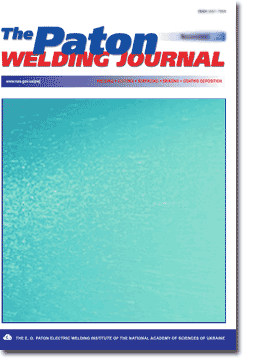

| Advances in laser technology. | 2 |
| LASER TECHNOLOGIES | |
|
Kovalenko V.S. Laser technology at a new stage of development. | 3 |
| The state-of-the-art and prospects of development of laser technologies and equipment for welding, cutting and various types of hardening treatments are analysed. Extremely high potential of laser processes for advancement of modern science and technology in the most important industries is shown, and the national experience in this area is noted. | |
|
Zeyffarth P. and Hoffmann J. Laser technologies in shipbuilding -reality and prospects. | 9 |
| Experience of development and application of laser technologies in shipbuilding, gained in Germany, is generalised. Comparison of the effectiveness of application of laser technologies and arc processes is made. Examples of the most effective laser applications in shipbuilding are given. | |
|
Garashchuk V.P. and Khaskin V.Yu. Prospects for using laser technologies in industry of Ukraine. | 16 |
| Positive properties of thermal laser technologies, such as cutting, welding, heat treatment, cladding and alloying, are described. Prospects for using laser technologies in industry of Ukraine are shown. Expediency of further development of some ingenious scientific-and-technical developments in the field of laser technologies, e.g. amorphization of metal surfaces is noted. | |
|
Bondarev A.A. and Bondarev Andr.A. Laser welding of aluminium alloys (Review). | 19 |
| The brief review is presented about weldability of aluminium alloys using a laser radiation. The effect of different factors on the stability of penetration of alloys and formation of joints, being free of any most widely spread defects, such as pores, cracks, oxide inclusions, is shown. The lack of necessary information about the load-carrying capacity of aluminium alloy joints made by the laser welding under the complex conditions of loading is outlined. | |
|
Staufer H. and Hackl H. Laser-MIG process for automotive industry. | 26 |
| Considered is a separate and combined effect of laser and arc radiation sources in welding of materials. In the latter cases it is possible to achieve a positive synergic effect, ensuring a simultaneous improvement in quality of joints and high productivity of the welding process at relatively low costs. | |
|
Krivtsun I.V. Peculiarities of penetration of metal in laser-arc welding using YAG laser. | 29 |
| Simplified model of thermal processes occurring in metal in combined laser-arc welding performed in the thermal conductivity penetration mode is suggested. The model allows for the effect of contraction of the anode region of the arc as resulting from laser evaporation of metals. Experimental and numerical investigations into peculiarities of penetration of stainless steel samples in combined welding using the YAG laser and the argon arc with a non-consumable electrode were conducted. Results of the calculations are in a sufficiently good agreement with the experimental data. | |
|
Hoffmann J. Reconditioning of exchangeable parts using laser technologies. | 33 |
| The paper describes the features of laser-powder spraying and laser surfacing application for repair and restoration of the specified contour of ship machinery parts, in particular, piston rods. Advantages of application of laser restoration technologies are demonstrated. | |
|
Anyakin N.I., Kovalenko V.S., Kozyrev A.S., Uno Y. and Khaled al-Sheboul. Imrovement of the efficiency and quality of laser processing of materials. | 35 |
| The paper presents the results of calculation and experimental studies of the technologies of laser welding of magnet core plates and laser cutting of semiconductors. Capabilities of laser technologies are demonstrated in terms of improvement of process efficiency and processing quality. | |
|
Golovko L.F., Dyveik J. and Oreshnik V.I. Assurance of quality of layers made by laser surfacing or strengthening treatment. | 43 |
| Method of changing the quality characteristics of surface layers produced by a laser surfacing or strengthening treatment is suggested. The feasibility of control of the cooling processes of the deposited layers by changing the space distribution of radiation power in the focusing plane is shown. Unique technical solutions were used for control of the space distribution of the laser radiation power. | |
|
Paton B.E., Korotynsky A.E., Kolesnik G.F., Litovchenko V.G. and Makarov A.V. Methods of designing devices for heliowelding. | 48 |
| The peculiarities of designing devices for heliowelding are considered. The classification of methods of designing devices of the mentioned class, including the direct transformation of solar energy, indirect transformation based on using different types of transducers, as well as combined transformation, is presented. It is shown that the indirect methods on the base of the photoelectric transducers are most promising at present. The description of a solar battery on the base of modules of the BFK-8-18 type is given. A schematic diagram of the welding installation is described, in which lead-acid cells, supplying a resonance transducer, are used as an intermediate accumulator of energy. | |
| Laser technologies for modern production. | 53 |
|
Hoffmann J. and Schmid K. Development and application of manual lasers for installation work. | 54 |
| The paper deals with the applications and advantages of manual lasers, special design features of heads, depending on their purpose (welding, cutting, surface treatment). Potential for material saving, when using laser technologies, is described. | |
|
Shternin L.A. and Smirnov N.V. Multi-purpose processing complexes, incorporating LGT-2.01M lasers. | 56 |
| The paper briefly describes the work of the Russian Welding Institute on development and improvement of processing complexes for welding and cutting low-carbon alloyed steels, brass, titanium, plastics, glass and other materials. Cases of effective application of laser technologies are presented. | |
|
Bondarev A.A. and Bondarev Andr.A. Device for a focusing lens protection from sprays and heating in laser welding. | 58 |
| Analysis of different variants of existing designs of a barrel for the laser welding is given. Results on improvement of the protection of a focusing lens in CO2-laser welding of aluminium alloys from sprays of metal vapours and its heating by the reflected beams are presented. New design solutions on manufacture of the barrel are offered taking into account the conditions of the laser welding of aluminium alloys. | |
| Index of articles for TPWJ'2001, No. 1-12. | 61 |
| List of authors | 67 |
| ADVERTISING | 71 |
(You are viewing the simplified file contents)
The cost of subscription/purchase order journals or individual articles
| Journal/Currency | Annual Set | 1 issue printed |
1 issue |
one article |
| TPWJ/USD | 384 $ | 32 $ | 26 $ | 13 $ |
| TPWJ/EUR | 348 € | 29 € | 24 € | 12 € |
| TPWJ/UAH | 7200 UAH | 600 UAH | 600 UAH | 280 UAH |
| AS/UAH | 1800 UAH | 300 UAH | 300 UAH | 150 UAH |
| AS/USD | 192 $ | 32 $ | 26 $ | 13 $ |
| AS/EUR | 180 € | 30 € | 25 € | 12 € |
| SEM/UAH | 1200 UAH | 300 UAH | 300 UAH | 150 UAH |
| SEM/USD | 128 $ | 32 $ | 26 $ | 13 $ |
| SEM/EUR | 120 € | 30 € | 25 € | 12 € |
| TDNK/UAH | 1200 UAH | 300 UAH | 300 UAH | 150 UAH |
| TDNK/USD | 128 $ | 32 $ | 26 $ | 13 $ |
| TDNK/EUR | 120 € | 30 € | 25 € | 15 € |
AS = «Automatic Welding» - 6 issues per year;
TPWJ = «PATON WELDING JOURNAL» - 12 issues per year;
SEM = «Electrometallurgy Today» - 4 issues per year;
TDNK = «Technical Diagnostics and Non-Destructive Testing» - 4 issues per year.


